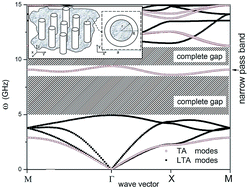Phononic band structure in carbon microtube composites
Abstract
In this work we have investigated theoretically the dispersion relation of mechanical waves propagating in an elastic solid medium reinforced by carbon microtubes arranged periodically in a square lattice. Based on classical elasticity theory, we obtained a generalized wave equation ignoring microscopic size effects. The wave equation is solved using the plane wave expansion method and numerical routines. The results for structures with lattice parameters of the order of micrometers show the presence of gaps that depend on the thickness of the microtubes’ walls. Our findings show that hollow inclusions maintain as large gaps as their massive counterparts until the ratio of the inner to the outer microtube radius is less than 20%. Therefore such structures are suitable for mechanical vibrations management. As an example, with appropriate parameters we have proposed a GHz transversal phononic band pass filter. The phonon density of states were also computed.


 Please wait while we load your content...
Please wait while we load your content...